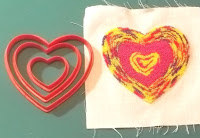Advent is considered the four weeks before Christmas and it
represents the coming of God to men. It
is often in churches represented by a wreath of 4 candles; each candle lit on
the Sundays of Advent with a fifth candle lit on Christmas Eve to represent Jesus.
There is also the tradition of the advent calendar. I love advent calendars. Those wonderful holiday pictures with the
numbered windows you open to reveal a little picture. I get one every year.
But many years ago I started a tradition with my mom to give
her advent gifts. I lived away from her
and so I would send a box of little gifts such as candy or Christmas stories or
poems or a little ornament for her to open each day until I arrived in my hometown
to spend the holidays with her and then could give her the rest in person.
I then started doing an advent for friends where I live. One year I did a progressive wall
hanging. I worked with a couple in a
quilting and monogramming shop. I
started an appliqué block by leaving a piece of fabric on one of the walls and
then every other day would take it down and add a new piece of the
picture. When I took it down I would
leave a poem or story or little piece of candy for them as a gift until I could
get the next piece added and then back up on the wall it would go. I had fun
and they enjoyed wondering what would come next.
I began to feel left out so I started doing advent for
me. I have plenty of holiday shows I
have bought or recorded over the years.
So I set up a schedule of holiday shows to watch every day along with
some planned activity like putting up the tree and then adding the lights or
working on my yearly Christmas ornaments.
I also have plenty of holiday books of stories and customs and never get
tired of reading them so I make sure before I go to sleep each night to read a
Christmas story. Occasionally I will buy
a piece of candy or a new ornament and give myself one of those to enjoy during
Advent. Just like with the Advent
calendar, it gives me a little surprise (If I buy the items early enough I will
forget I have them so it is a surprise.)
I always thought it would be a great idea for children to
help them handle the excitement of waiting for Santa’s visit. Just plan a little gift or activity for them
each day. Make a visit to Santa Claus something they can anticipate (or make it
a surprise). Maybe take them shopping to
buy another child a Christmas gift like with the toys for charity programs that
are often available.
Remember my blog on Cookie cutters I reposted just a couple
of weeks ago. Plan a day of paper
‘cookie’ ornament making. You might even
want to cut out the ‘cookies’ from colored construction or card stock paper so
it looks more ‘frosted’. Don’t forget to
get some glitter or sequins to add a little sparkle.
It is a lot of fun to plan and a lot of fun to do. And don’t just do Advent for the little
ones. Plan one for your spouse, your
parents and of course, plan one for yourself.
I found it helped me stay in the holiday mood when the hustle and bustle
of the holidays got to be a little overwhelming. And have yourself a merry little Advent fun.
©2017 - Cheryl Fillion

















